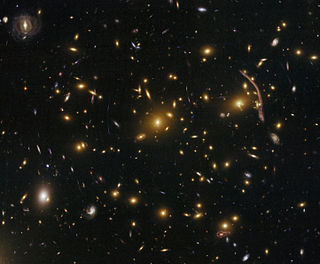Abell 754 is a galaxy cluster in the constellation Hydra that was formed from the collision of two smaller clusters. This collision, which began about 300 million years ago, is ongoing, and the system is still disturbed. Eventually, the cluster will reach a level of equilibrium in a few billion years.

Abell 400 is a galaxy cluster which contains the galaxy NGC 1128 with two supermassive black holes spiraling towards merger.

Abell 2667 is a galaxy cluster. It is one of the most luminous galaxy clusters in the X-ray waveband known at a redshift about 0.2.

Abell 370 is a galaxy cluster located nearly 5 billion light-years away from the Earth, in the constellation Cetus. Its core is made up of several hundred galaxies. It was catalogued by George Abell, and is the most distant of the clusters he catalogued.

Abell 383 is a galaxy cluster in the Abell catalogue.

Abell 2147 is a galaxy cluster in the Abell catalogue. It is located within the core of the Hercules Superclusters, within Serpens Caput, near the cluster Abell 2152, approximately two degrees south southwest of the Hercules Cluster. It is possible that Abell 2147 is actually part of the Hercules Cluster considering that it shares the same redshift of 550 million light years.
Abell 133 is a galaxy cluster in the Abell catalogue.

Abell 262 is a galaxy cluster in the Abell catalogue. It is part of the Perseus–Pisces Supercluster, one of the largest known structures in the universe. Although its central galaxy, NGC 708, is a giant cD galaxy, most of its bright galaxies are spirals, which is unusual for a galaxy cluster. With approximately 200 members it is a comparatively small cluster.

Abell 1413 is a massive and rich type I galaxy cluster straddling the border between the constellations Leo and Coma Berenices, with the projected comoving distance of approximately 640 Mpc (2.1 billion ly). The cluster is especially notable due to the presence of its very large brightest cluster galaxy (BCG), one of the most extreme examples of its type, as well as one of the largest galaxies known. The cluster was first noted by George O. Abell in 1958.

Abell 1795 is a galaxy cluster in the Abell catalogue.
Abell 222 is a galaxy cluster in the constellation of Cetus. It holds thousands of galaxies together. It is located at a distance of 2.4 billion light-years from Earth.
Abell 2152 is a bimodal galaxy cluster and one of three clusters comprising the Hercules Supercluster. It contains 3 BCGs; the S0 lenticular UGC 10204, the pair UGC 10187, and the SA0 unbarred lenticular CGCG 108-083. In total there are 41 galaxies which are confirmed to be members of the cluster. The cluster is classified as a Bautz-Morgan type III and Rood-Sastry class F cluster, indicating morphological irregularity and perhaps dynamical youth. It is receding from the Milky Way galaxy with a velocity of 12385 km/s.
Abell 3742 is a galaxy cluster located around 200 million light-years from Earth in the constellation Indus. The cluster's brightest member is the elliptical galaxy NGC 7014. Abell 3742 is located in the Pavo–Indus Supercluster and is one of three major clusters along with Abell 3656 and Abell 3698.

ESO 444-46 is a class E4 supergiant elliptical galaxy; the dominant and brightest member of the Abell 3558 galaxy cluster around 195 megaparsecs away in the constellation Centaurus. It lies within the core of the massive Shapley Supercluster, one of the closest neighboring superclusters. It is one of the largest galaxies in the local universe, and possibly contains one of the most massive black holes known. The black hole's mass is very uncertain, with estimates ranging from as low as 501 million M☉, to as high as 77.6 billion M☉.

NGC 1279 is a lenticular galaxy estimated to be 324 million light-years away from the Milky Way in the constellation Perseus. It has diameter of about 110,000 ly, and is a member of the Perseus Cluster.

NGC 6158 is an elliptical galaxy located about 400 million light-years away in the constellation Hercules. The galaxy was discovered by astronomer William Herschel on March 17, 1787 and is a member of Abell 2199.
Abell 1146 is a rich galaxy cluster in the constellation Crater. Its richness class is 4, and it is located about 2 billion light-years away.

NGC 703 is a lenticular galaxy located 240 million light-years away in the constellation Andromeda. The galaxy was discovered by astronomer William Herschel on September 21, 1786 and is also a member of Abell 262.

NGC 709 is a lenticular galaxy located 150 million light-years away in the constellation Andromeda. It was discovered by the Irish engineer and astronomer Bindon Blood Stoney on October 28, 1850 and is a member of the galaxy cluster Abell 262.

NGC 543 is an elliptical galaxy located around 324 million light-years away in the constellation Cetus. NGC 543 was discovered on October 31st, 1864 by Heinrich Louis d'Arrest. It is not known to have much star formation, and it is a member of the galaxy cluster Abell 194.














